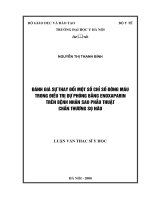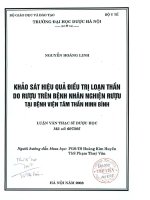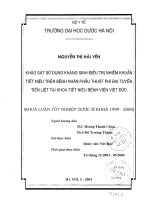Tối Ưu Điều Trị Thuyên Tắc Phổi Cấp Trên Bệnh Nhân Có Tiền Sử Nhồi Máu Cơ Tim
Bạn đang xem bản rút gọn của tài liệu. Xem và tải ngay bản đầy đủ của tài liệu tại đây (1.59 MB, 28 trang )
Tối ưu điều trị thuyên tắc phổi cấp
trên bệnh nhân có tiền sử
nhồi máu cơ tim
Bs. Nguyễn Ngô Thanh Phương
BS. Đinh Đức Huy
Bv Tim Tâm Đức
Trường hợp lâm sàng
•
•
•
•
•
•
Bệnh nhân C. J, 50 tuổi
BMI 28 (CC 183cm, CN 96kg)
Hút thuốc lá(+)
Rối loạn mỡ máu (+)
THA (-), ĐTĐ (-)
Tiền căn NMCT ST chênh lên (2011) can thiệp
1 stent không phủ thuốc vào đoạn đầu LAD
• Điều trị : Aspirin, Bisoprolol, Losartan,
Rosuvastatin
• BN không triệu chứng
Trường hợp lâm sàng
•
•
•
•
•
•
•
•
•
•
1 tháng trước, bệnh nhân bay từ HCM-London
Khó thở khi gắng sức ngày càng tăng
Đau chân bên phải
Nhập viện vì khó thở
Tỉnh táo, không dấu thần kinh khu trú, không sốt
TST 88 bpm
HA 135/80 mmHg
TS thở 16 bpm SpO2 96% (room air)
Tim đều, không âm thổi
Phổi trong
Chân bên phải hơi lớn hơn chân bên trái
Xét nghiệm
•
•
•
•
•
BC 9.7k/uL, HGB 15 g/dL, TC 200K/uL
Creatinin 101 mmol/L, eGFR:78ml/ph/1.73m2
Hs-CRP 70mg/L
AST 26 U/L
ALT 28 U/L
Cholesterol 2.1
HDL-C 0.5
LDL-C 1.5
TG: 1.2
mmol/L
• NT proBNP 1692pg/ml
• Hs-TnT 21-22 pg/ml
• D-Dimer 5990 ng/mL
ECG
Sinus rythm, 85 bpm, normal QRS axis and PR interval
Cận lâm sàng
Siêu âm tim
• EF 62%, không RLVĐ vùng
• Không bệnh lý van tim
• Không tăng áp phổi (PAPs
=20mmHg)
• Không huyết khối
• Lớn thất phải, TAPSE 19
Siêu âm mạch máu
• Tắc hoàn toàn tĩnh mạch
đùi nông bên phải
• Huyết khối lan tỏa đến
tĩnh mạch khoeo bên phải
CTR: 0.55
Tuần hoàn phổi bên phải giảm
Chẩn đoán
Thuyên tắc phổi/ Nhồi máu cơ tim đã đặt 1 stent
Xác định bằng MSCT phổi
Xử trí
Ngày 1-2:
Enoxaparin 0.9ml TDD /12 giờ
Acenocoumarol 1mg / ngày
ASA 81mg /ngày
Bisoprolol 2.5mg /ngày
Losartan 25mg /ngày
Rosuvastatin 10mg /ngày
Ngày 3: Bệnh nhân từ chối kiểm tra INR hằng
ngày
VTE treatment with VKAs
•
•
•
•
VKAs = standard treatment for VTE (PE & DVT)
Highly prevent recurrent VTE (RRR 85% vs placebo)
Recurrence risk of 3% with patient on treatment
Limitations of VKA treatment
need frequent INR monitoring
major bleeding of 2.1% during the first 6 months of treatment
case-fatality rate 11%
intracranial bleeding 8.7% of major bleeds with mortality risk of 46%
most major bleeds occur during the first weeks of VKA treatment
N Engl J Med 2012;366:1287-97
EINSTEIN PE: study design
Randomized, open-label, event-driven, non-inferiority study
• Up to 48 hours’ heparins/fondaparinux treatment permitted before study entry
• 88 primary efficacy outcomes needed
• Non-inferiority margin: 2.0
Predefined treatment period of 3, 6, or 12 months
Day 1
Objectively
confirmed PE ±
DVT
N=4833
Day 21
Rivaroxaban
Rivaroxaban
15 mg bid
20 mg od
R
Enoxaparin bid for at least 5 days,
plus VKA INR 2.5 (range 2.0–3.0)
Primary efficacy outcome: first recurrent VTE
Principal safety outcome: first major or nonmajor clinically relevant bleeding
30-day poststudy
treatment
period
Patient flow
Rivaroxaban
*As treated
Enoxaparin/VKA
2420
Randomized
(N=4833)
2413
2419
ITT population
2413
2412
Safety population*
2405
2224
Per-protocol population
2238
66
Withdrawal of consent
118
8
Lost to follow-up
10
EINSTEIN PE: primary efficacy
outcome analysis
Rivaroxaban
(N=2419)
First symptomatic recurrent VTE
Recurrent DVT
Recurrent DVT + PE
Non-fatal PE
Fatal PE/unexplained death where
PE cannot be ruled out
Enoxaparin/VKA
(N=2413)
n
(%)
n
(%)
50
(2.1)
44
(1.8)
18
0
22
(0.7)
(0.9)
17
2
19
(0.7)
(<0.1)
(0.8)
10
(0.4)
6
(0.2)
HR
1.12
0.75
0
1.68*
1.00
2.00
Rivaroxaban
superior
Rivaroxaban
non-inferior
p=0.57 for superiority
(two-sided)
P=0.0026 for non-inferiority
(one-sided)
Rivaroxaban
inferior
*Potential relative risk increase <68.4%; absolute risk difference 0.24% (–0.5 to 1.02)
Cumulative event rate (%)
EINSTEIN PE: principal safety outcome –
major or non-major clinically relevant bleeding
Enoxaparin/VKA
N=2405
15
14
13
12
11
10
9
8
7
6
5
4
3
2
1
0
Rivaroxaban
N=2412
0
30
60
90
120
150
Rivaroxaban
n/N (%)
Enoxaparin/VKA
n/N (%)
HR (95% CI)
p-value
249/2412
(10.3)
274/2405
(11.4)
0.90 (0.76–1.07)
p=0.23
180
210
240
270
300
330
360
Time to event (days)
Number of patients at risk
Rivaroxaban
2412 2183
2133
2024
1953
1913
1211
696
671
632
600
588
313
Enoxaparin/VKA
2405 2184
2115
1990
1923
1887
1092
687
660
620
589
574
251
Safety population
Cumulative event rate (%)
EINSTEIN PE: major bleeding
3.0
Rivaroxaban
n/N (%)
Enoxaparin/VKA
n/N (%)
HR (95% CI)
p-value
2.5
26/2412
(1.1)
52/2405
(2.2)
0.49 (0.31–0.79)
p=0.0032
Enoxaparin/VKA
N=2405
2.0
1.5
1.0
Rivaroxaban
N=2412
0.5
0.0
0
30
60
90
120
150
180
210
240
270
300
330
360
Time to event (days)
Number of patients at risk
Rivaroxaban
2412 2281
2248
2156
2091
2063
1317
761
735
700
669
659
350
Enoxaparin/VKA
2405 2270
2224
2116
2063
2036
1176
746
719
680
658
642
278
Safety population
EINSTEIN PE: conclusions
In patients with acute symptomatic PE with or without DVT,
rivaroxaban showed:
Non-inferiority to LMWH/VKA for efficacy
HR=1.12 (0.75–1.69); pnon-inferiority =0.0026
for non-inferiority margin of 2.0
Similar findings for principal safety outcome
HR=0.90 (0.76–1.07); p=0.23
Superiority for major bleeding
HR=0.49 (0.31–0.79) p=0.0032
Consistent efficacy and safety results irrespective of age,
body weight, gender, kidney function and cancer
No evidence for liver toxicity
Clinical trials of NOACs for PE acute phase
Systemic review and meta-analysis
Introduction:
Meta-analysis to determine the efficacy and safety of NOACs as
compared with those of VKAs in patients with acute VTE
Methods:
MEDLINE, EMBASE, the Cochrane Database of Systematic Reviews
and the Clinical Trials Registry up to October 2013. Eligible studies
included phase 3 trials comparing NOACs with VKAs in patients with
acute VTE. RRs, absolute risk differences and NNTs to prevent one
event were calculated for recurrent VTE, fatal PE, overall mortality,
major bleeding, and other bleeding complications, with randomeffects models.
Study outcomes & Definitions
1. Efficacy outcomes
Recurrent VTE, fatal PE, and overall mortality
2. Safety outcomes
Major bleeding, non-fatal major bleeding at a critical site,
clinically relevant non-major bleeding, non-fatal intracranial
bleeding, major gastrointestinal bleeding, and fatal bleeding
during anticoagulant treatment
3. Definition of major bleeding
Overt and associated with a decrease in the Hb level of
≥2g/dL, requiring transfusion of at least 2 units of blood,
occurring in a critical site (intracranial, intraspinal, intraocular,
pericardial, intra-articular intramuscular with compartment
syndrome, retroperitoneal), or contributing to death
Study selection
Study characteristics
Main findings
1. Five studies were included, 4 NOACs (rivaroxaban, dabigatran,
apixaban, edoxaban) in 24 455 patients with acute VTE
2. RR for
recurrent VTE
0.88 (95% CI 0.74–1.05)
fatal PE
1.02 (95% CI 0.39–5.96)
overall mortality
0.97 (95% CI 0.83–1.14)
major bleeding
0.60 (95% CI 0.41–0.88)
fatal bleeding
0.36 (95% CI 0.15–0.87)
3. NNT to prevent
one major bleed
149
one fatal bleed
1111
4. No significant differences between individual NOACs and
rivaroxaban (Fixed-effect network analysis )
Efficacy outcomes
Recurrent VTE
Fatal PE
Mortality
241/12 151 patients (2.0%) vs
9/12 151 patients (0.07%) vs
290 /12 197 patients (2.4%) vs
273 /12 153 patients (2.2%)
9/12 153 patients (0.07%)
298 /12 193 patients (2.4%)
Safety outcomes









